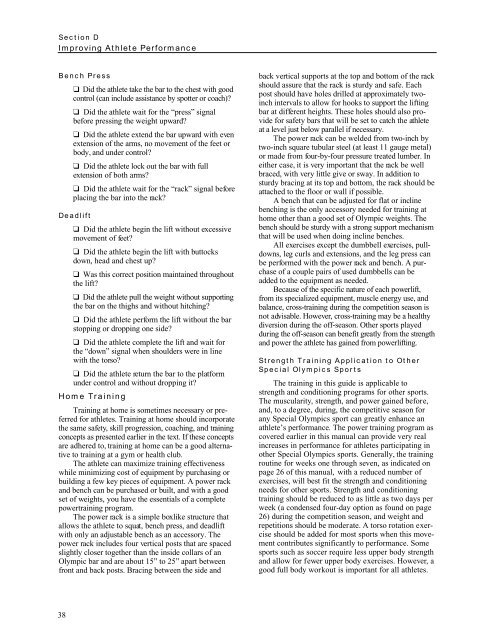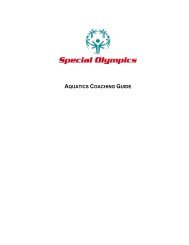Powerlifting Coaching Guide - Special Olympics
Powerlifting Coaching Guide - Special Olympics
Powerlifting Coaching Guide - Special Olympics
Create successful ePaper yourself
Turn your PDF publications into a flip-book with our unique Google optimized e-Paper software.
Section D<br />
Improving Athlete Performance<br />
Bench Pre s s<br />
38<br />
❑ Did the athlete take the bar to the chest with go o d<br />
c o n t rol (can include assistance by spotter or coach ) ?<br />
❑ Did the athlete wait for the “ p re s s ”signal<br />
b e fo re pressing the weight upwa rd ?<br />
❑ Did the athlete extend the bar upwa rd with eve n<br />
extension of the arm s , no movement of the feet or<br />
b o dy, and under contro l ?<br />
❑ Did the athlete lock out the bar with full<br />
ex t e n s i o nof both arm s ?<br />
❑ Did the athlete wait for the “ ra ck ” signal befo re<br />
placing the bar into the ra ck ?<br />
D e a d l i f t<br />
❑ Did the athlete begin the lift without ex c e s s ive<br />
m ovement of fe e t ?<br />
❑ Did the athlete begin the lift with bu t t o cks<br />
d ow n ,head and chest up?<br />
❑ Was this correct position maintained thro u g h o u t<br />
the lift?<br />
❑ Did the athlete pull the weight without support i n g<br />
the bar on the thighs and without hitch i n g ?<br />
❑ Did the athlete perfo rm the lift without the bar<br />
stopping or dropping one side?<br />
❑ Did the athlete complete the lift and wait for<br />
the “ d ow n ”signal when shoulders we re in line<br />
with the tors o ?<br />
❑ Did the athlete re t u rn the bar to the plat fo rm<br />
under control and without dropping it?<br />
Home Tr a i n i n g<br />
Training at home is sometimes necessary or prefe<br />
rred for athletes. Training at home should incorp o rat e<br />
the same safe t y, skill progre s s i o n ,c o a ch i n g, and tra i n i n g<br />
c o n c epts as presented earlier in the text. If these concep t s<br />
a re adhered to, t raining at home can be a good altern at<br />
ive to training at a gym or health cl u b.<br />
The athlete can maximize training effe c t ive n e s s<br />
while minimizing cost of equipment by purchasing or<br />
building a few key pieces of equipment. A power ra ck<br />
and bench can be purchased or bu i l t , and with a go o d<br />
set of we i g h t s , you have the essentials of a complete<br />
p owe rt raining program.<br />
The power ra ck is a simple box l i ke stru c t u re that<br />
a l l ows the athlete to squat , b e n ch pre s s , and deadlift<br />
with only an adjustable bench as an accessory. Th e<br />
p ower ra ck includes four ve rtical posts that are spaced<br />
s l i g h t ly closer together than the inside collars of an<br />
O lympic bar and are about 15” to 25” ap a rt betwe e n<br />
f ront and back posts. Bracing between the side and<br />
b a ck ve rtical supports at the top and bottom of the ra ck<br />
should assure that the ra ck is sturdy and safe. Each<br />
post should have holes drilled at ap p rox i m at e ly two -<br />
i n ch intervals to allow for hooks to support the lifting<br />
bar at diffe rent heights. These holes should also provide<br />
for safety bars that will be set to c at ch the at h l e t e<br />
at a level just below parallel if necessary.<br />
The power ra ck can be welded from two - i n ch by<br />
t wo - i n ch square tubular steel (at least 11 ga u ge metal)<br />
or made from fo u r- by - four pre s s u re tre ated lumber. In<br />
either case, it is ve ry important that the ra ck be we l l<br />
b ra c e d, with ve ry little give or sway. In addition to<br />
s t u rdy bracing at its top and bottom, the ra ck should be<br />
at t a ched to the floor or wall if possibl e.<br />
A bench that can be adjusted for fl at or incl i n e<br />
b e n ching is the only accessory needed for training at<br />
home other than a good set of Olympic weights. Th e<br />
b e n ch should be sturdy with a strong support mech a n i s m<br />
t h at will be used when doing incline benches.<br />
All exe rcises ex c ept the dumbbell exe rc i s e s , p u l ld<br />
ow n s ,l eg curls and ex t e n s i o n s ,and the leg press can<br />
be perfo rmed with the power ra ck and bench. A purchase<br />
of a couple pairs of used dumbbells can be<br />
a dded to the equipment as needed.<br />
Because of the specific nat u re of each powe rl i f t ,<br />
f rom its specialized equipment, mu s cle energy use, a n d<br />
b a l a n c e, c ro s s - t raining during the competition season is<br />
not adv i s abl e. Howeve r, c ro s s - t raining may be a healthy<br />
d ive rsion during the off-season. Other sports playe d<br />
d u ri n gthe off-season can benefit gre at ly from the stre n g t h<br />
and power the athlete has gained from powe rl i f t i n g.<br />
S t rength Training Application to Other<br />
<strong>Special</strong> <strong>Olympics</strong> Sport s<br />
The training in this guide is applicable to<br />
strength and conditioning programs for other sports.<br />
The muscularity, strength, and power gained before,<br />
and, to a degree, during, the competitive season for<br />
any <strong>Special</strong> <strong>Olympics</strong> sport can greatly enhance an<br />
athlete’s performance. The power training program as<br />
covered earlier in this manual can provide very real<br />
increases in performance for athletes participating in<br />
other <strong>Special</strong> <strong>Olympics</strong> sports. Generally, the training<br />
routine for weeks one through seven, as indicated on<br />
page 26 of this manual, with a reduced number of<br />
exercises, will best fit the strength and conditioning<br />
needs for other sports. Strength and conditioning<br />
training should be reduced to as little as two days per<br />
week (a condensed four-day option as found on page<br />
26) during the competition season, and weight and<br />
repetitions should be moderate. A torso rotation exercise<br />
should be added for most sports when this movement<br />
contributes significantly to performance. Some<br />
sports such as soccer require less upper body strength<br />
and allow for fewer upper body exercises. However, a<br />
good full body workout is important for all athletes.

















